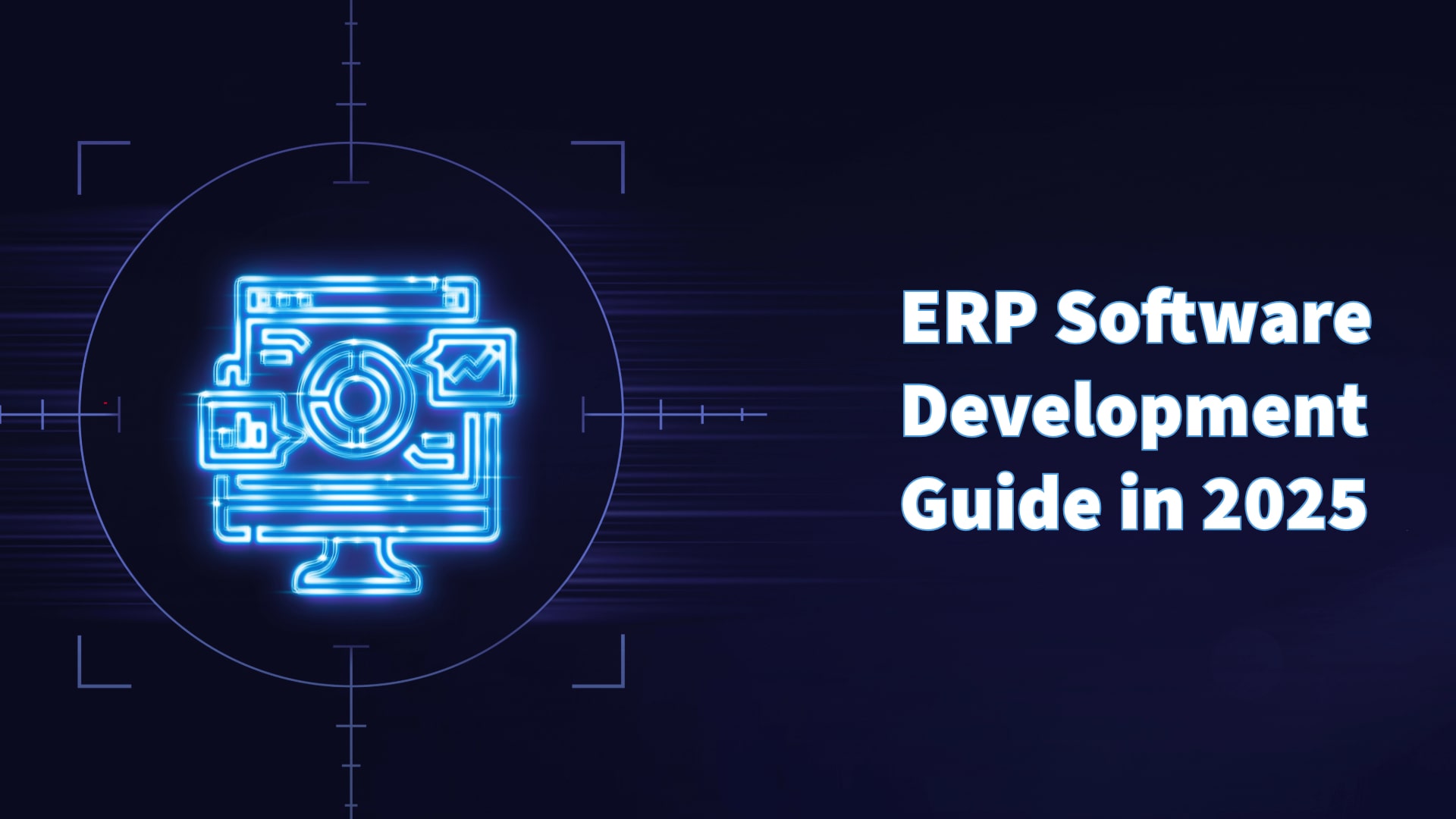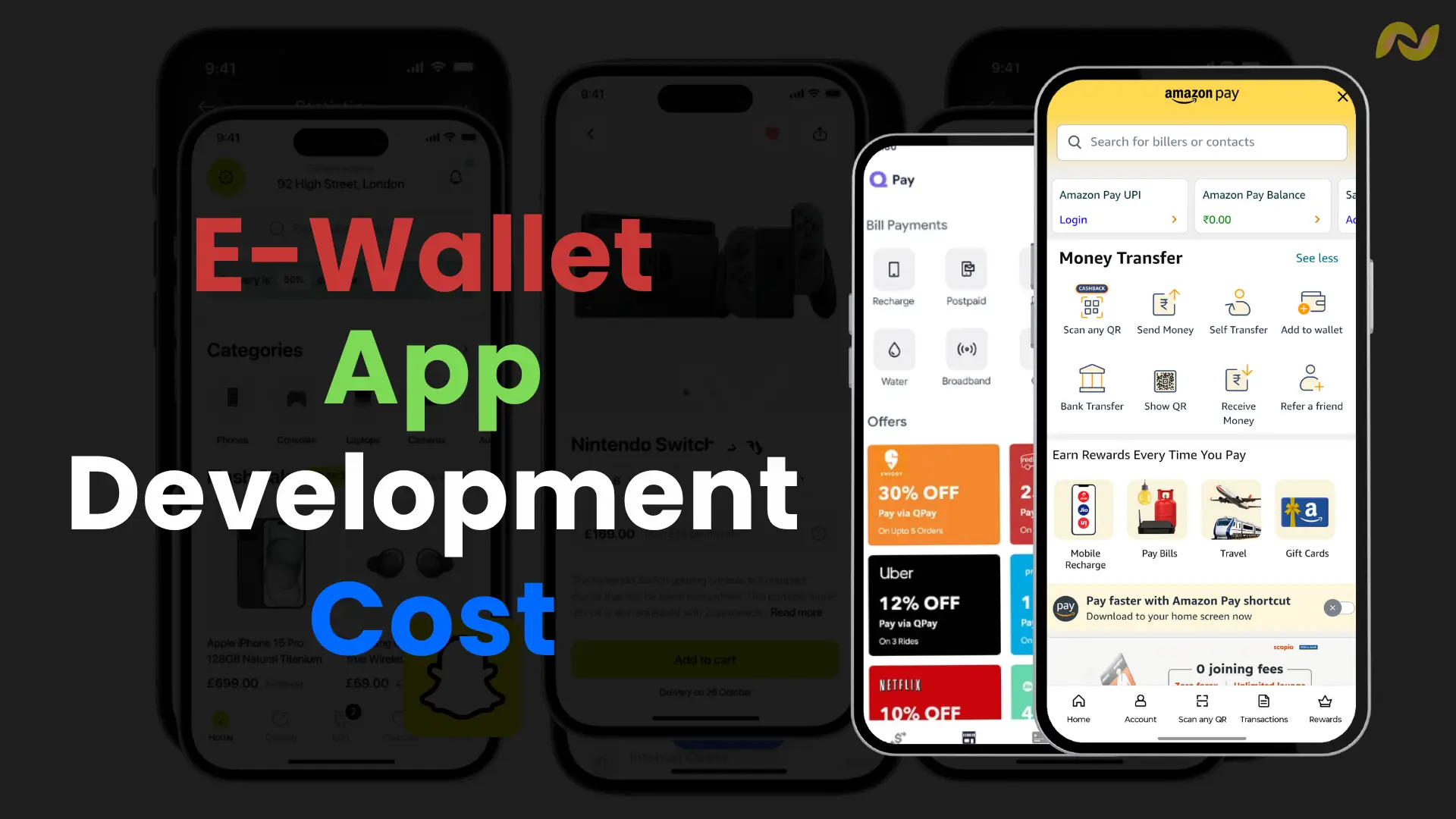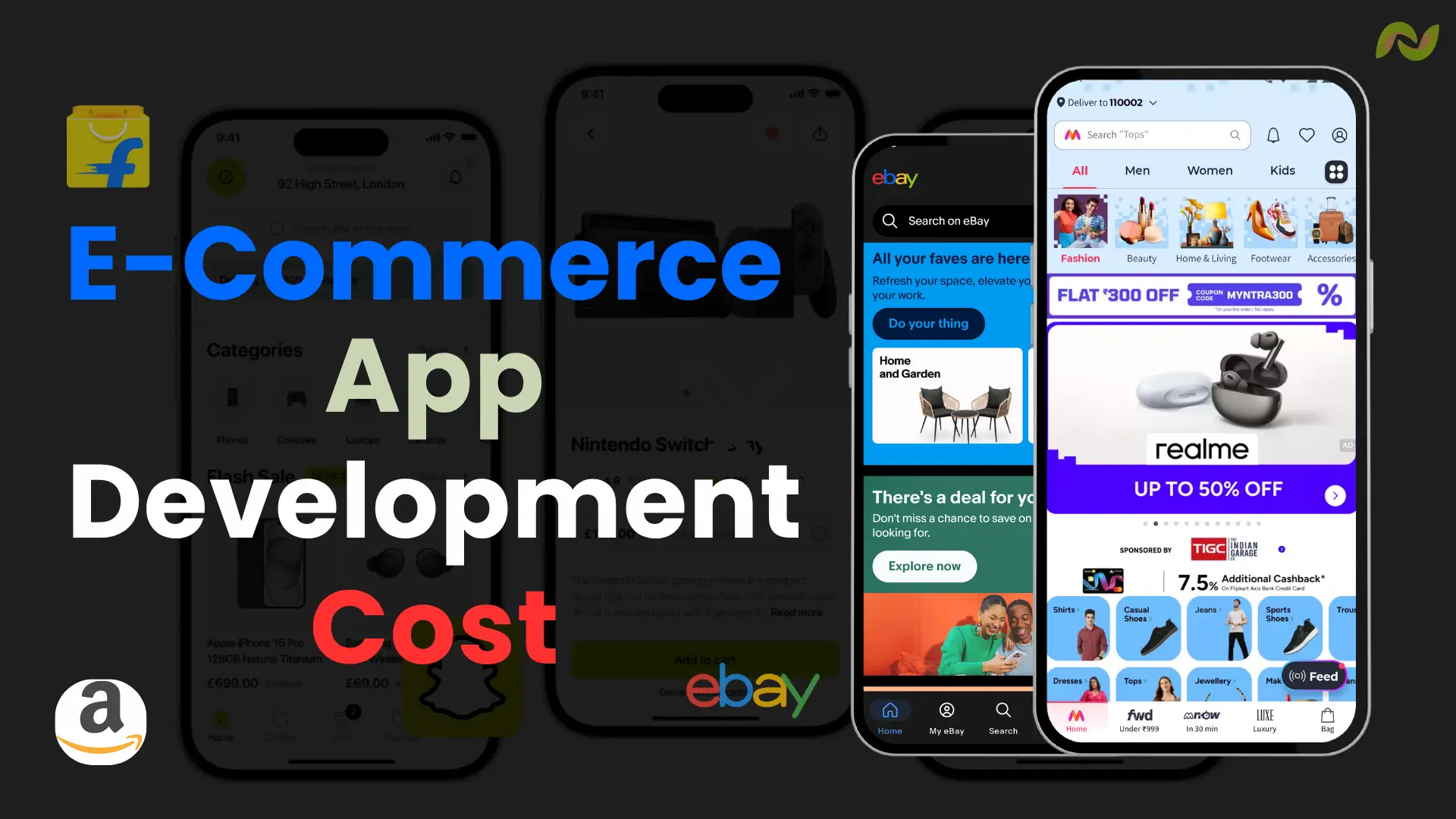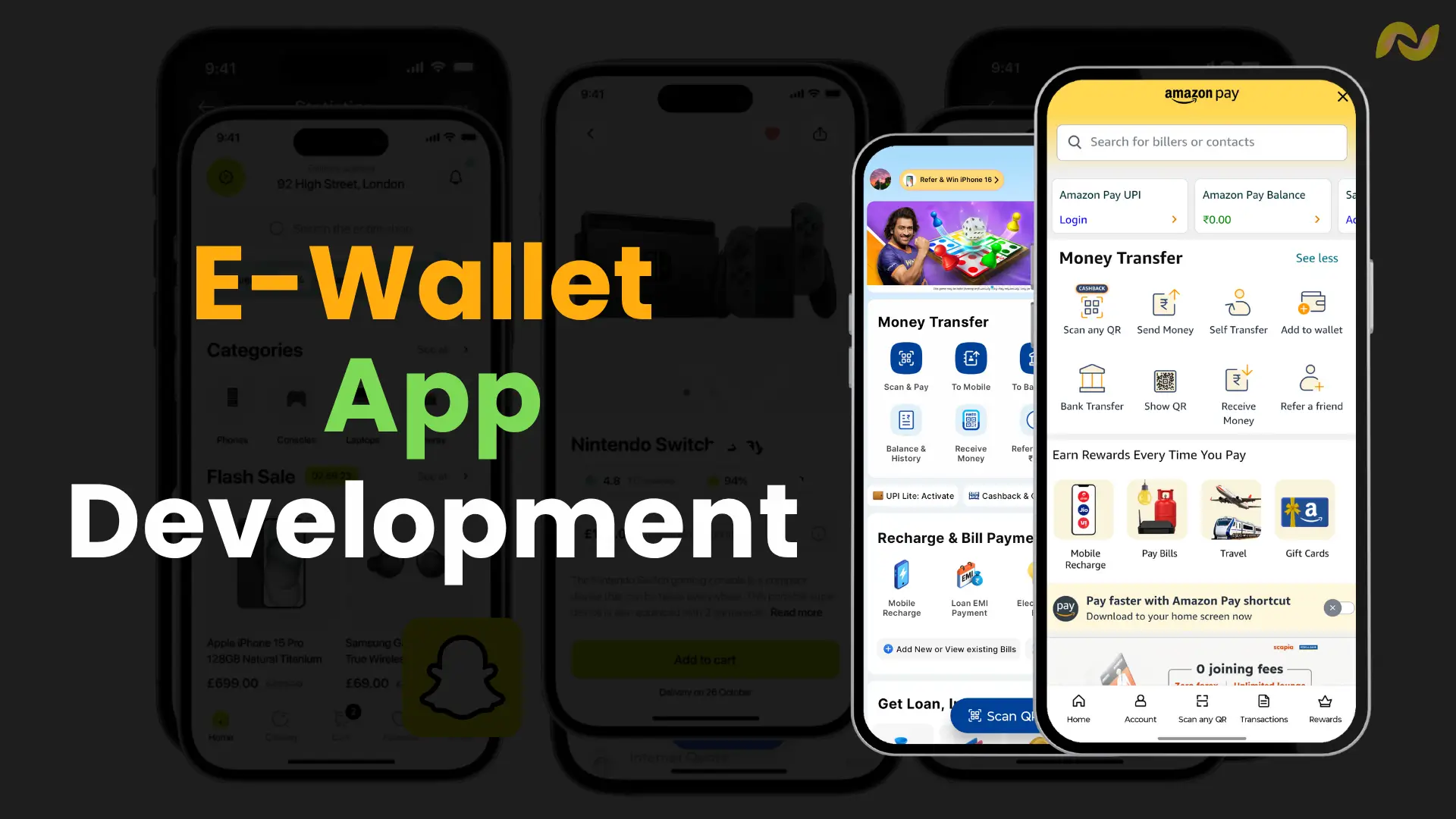ERP Software Development: Features, Costs, and Process
Success in today’s business world demands more than hard work; you need the right tools and technology to improve activities, upgrade efficiency, and drive persistent development. But in modern times, where time is very crucial, it becomes very necessary to be more productive to catch up with the industry trends. To make their employees more efficient, companies require sophisticated ERP software systems to manage and streamline their workflow by automating repetitive and manual tasks and freeing employees from unnecessary time-consuming tasks. But behind this ERP software lies complex engineering that we will discuss in this guide. If you are a developer wanting to gather knowledge or a business owner wanting to develop an ERP system with the help of an ERP software development company, it is crucial to know the cost, features, and processes of enterprise software development. Let’s start this journey!
Table of Contents
ToggleWhat is ERP Software?
ERP means Enterprise Resource Planning. ERP is software that is widely used by businesses to manage their day-to-day tasks and activities in different fields such as finance, supply chain, logistics, sales, marketing, manufacturing, manufacturing, human resources, etc. ERP offers centralized storage and enables smooth data flow within the organization. Modern businesses heavily rely on the implementation of ERP systems to effectively manage their operations.
Global Market Statistics of the ERP Software Market in 2025
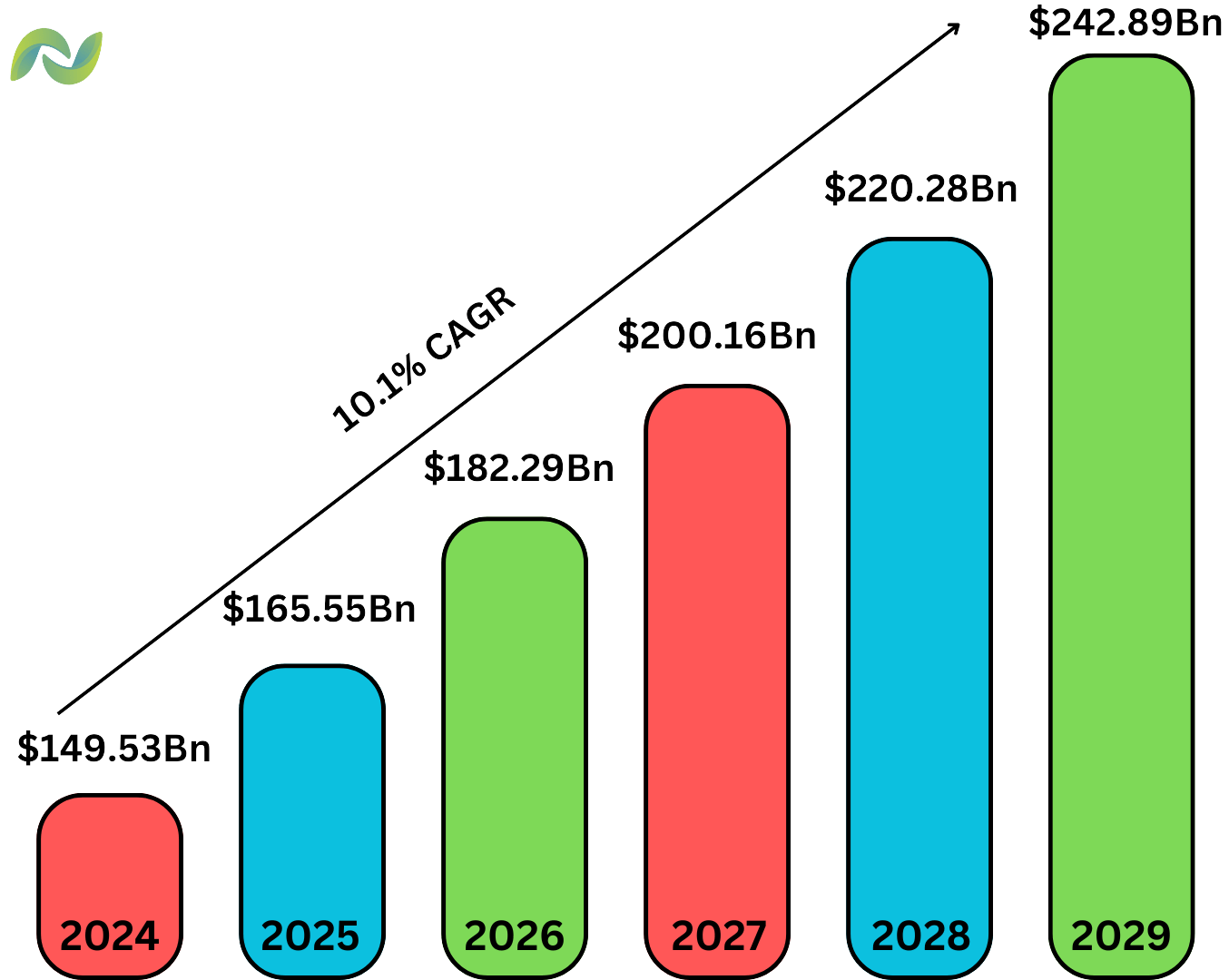
According to a report by The Business Research Company, the market cap of the ERP software industry was $149.53 billion in 2024 and reached $165.55 billion in 2025. With a CAGR of 10.1%, the market cap is expected to hit $242.89 billion in 2029.
What is ERP Software Development?
It is the process of defining and developing ERP software that includes making custom-made programming frameworks to oversee and coordinate different business processes across various divisions within an organization. This implies planning simple-to-utilize interfaces, making strong data sets, coding important capabilities, and guaranteeing the product can develop with the organization while keeping information safe. When building an ERP, you want a design stage to design your item exhaustively, an improvement stage to execute everything you’ve planned and arranged, and present delivery support on fixing issues with and working on your foundation. When done well, ERP software can streamline tasks, support productivity, and give a comprehensive perspective on significant data and overall operations within the business.
The Backbone of ERP Systems: Understanding Different Modules
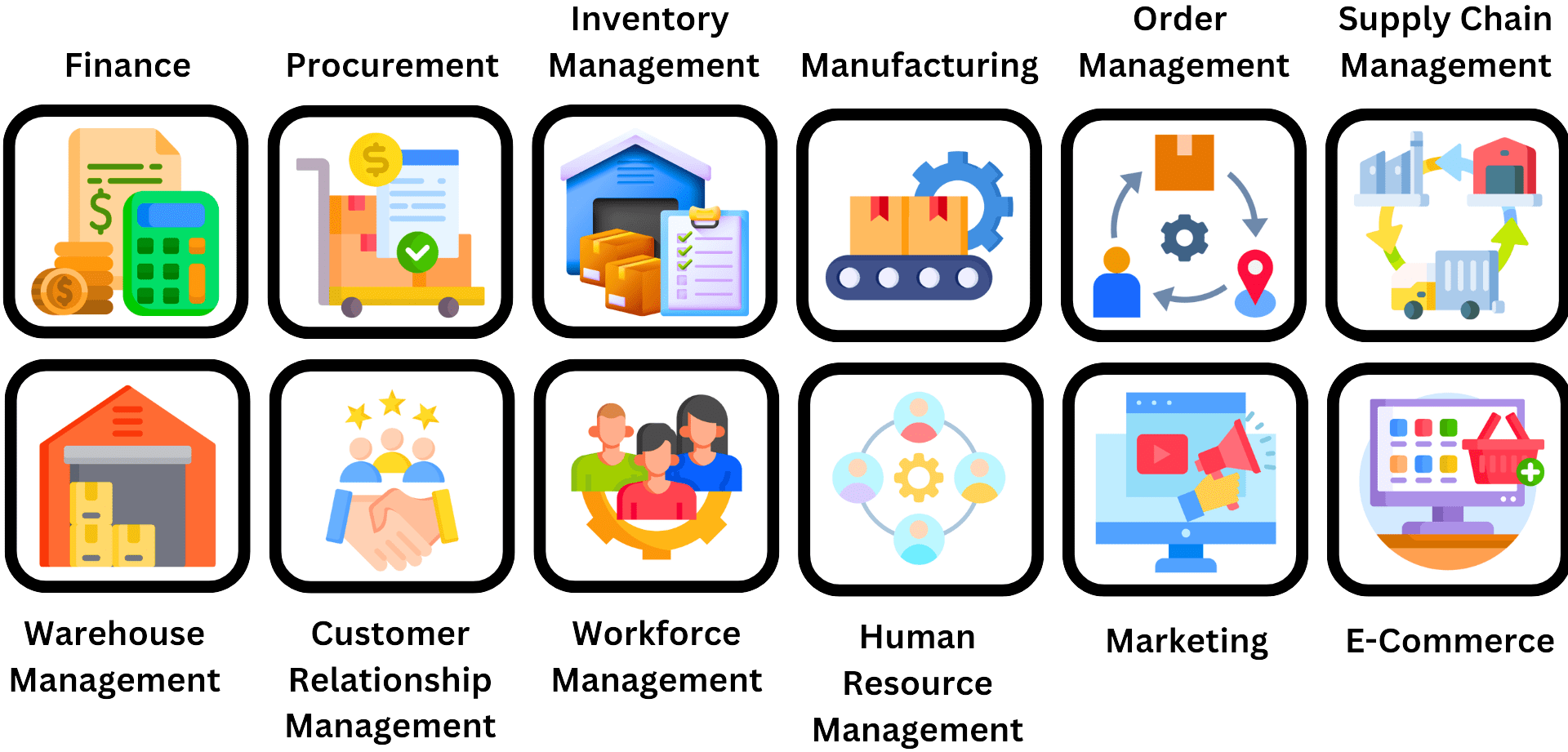
Every ERP software consists of several different modules. Each module is specifically designed and developed for a specific business function. Each unique module has its data and processes related to the business function. Each module is like a plug that can be integrated with the ERP to have an accurate and centralized source of data and data flow. There are several core modules and additional modules that work with the ERP:
[1] Finance
Features: Cash management, Budgeting, General Ledger, Tax Compliance, etc.
Tasks: Invoice Processing, Managing payments, Generating financial reports, etc.
[2] Procurement
Features: Vendor management, Purchase order creation, Procurement analysis, etc.
Tasks: Tracking deliveries, requesting quotations, generating purchase orders, etc.
[3] Inventory Management
Features: Stock Tracking, Multi-location inventory management, Inventory evaluation, etc.
Tasks: Monitoring stock, handling inventory, preventing stockouts, etc.
[4] Manufacturing
Features: Production scheduling, Bill of materials, Quality control, Resource management, etc.
Tasks: Planning production, issuing work orders, ensuring product quality, etc.
[5] Order Management
Features: Order processing, Order tracking, Price management, Returns management, etc.
Tasks: Processing customer orders, tracking delivery status, generating invoices, etc.
[6] Supply Chain Management
Features: Supply chain visibility, Demand planning, Risk management, Logistics and supplier coordination, etc.
Tasks: Optimizing logistics, forecasting demand, managing supplier relationships, etc.
[7] Warehouse Management
Features: Storage optimization, Warehouse automation, Shipping management, etc.
Tasks: Assigning storage locations, Processing shipments, handling warehouse transfers, etc.
[8] Customer Relationship Management
Features: Lead tracking, Contact Management, Marketing automation, Sales forecasting, etc.
Tasks: Managing customer interaction, monitoring sales pipelines, sending automated emails, etc.
[9] Workforce Management
Features: Employee scheduling, Timekeeping, Workforce analytics, Absence management, etc.
Tasks: Tracking attendance, scheduling employees, handling leave requests, Absence management, etc.
[10] Human Resource Management
Features: Recruitment management, Employee records, Payroll processing, Employee training, etc.
Tasks: Managing hiring, Processing salaries, conducting appraisals, implementing training, etc.
[11] Marketing
Features: SEO Tools, Campaign management, Analytics dashboard, Content management, etc.
Tasks: Creating campaigns, optimizing search rankings, scheduling social media posts, analyzing customer reach, etc.
[12] E-Commerce
Features: Payment gateways, Product catalogs, User account management, Shopping carts, etc.
Tasks: Processing online payments, Listing the products, Handling promotions, Tracking online sales, etc.
How ERP Modules Help Businesses Minimize Costs and Maximize Profits?
ERP modules’ greatest advantage is their capacity to give real-time data and experiences across the whole organization. ERP Modules also assist organizations with further developing joint efforts and communication between offices. By giving an incorporated stage to information storage and sharing, modules separate data repositories and guarantee that everybody is working on the same information. Many mid-sized to large enterprises have adopted ERP solutions and are opting for custom ERP software systems, playing their critical role in driving business success.
[1] Stock Handling: Suppose a hotel management business requires constant administration of linen stock and other housekeeping instruments through stock requests; an ERP framework can automate this cycle for you behind the scenes. Never again do you want to stress over running dangerously short on stock; an ERP framework can reorder stock or remind the buyer once it recognizes levels are draining.
[2] Eliminate the Need for Multiple Software: In any business, juggling separate systems for bookkeeping, tracking shipments, managing customer relationships, and handling inventory can create major roadblocks. When these systems aren’t designed to work together, it often leads to costly mistakes. By embracing custom ERP development, you can manage all these tasks from a unified database.
[3] Easy Integration Into Your Business: Custom ERP software can resolve your issue of combining your information from various divisions across different data sets, and the benefits of having a concentrated ERP framework become unlimited. It smoothes out the detailing system, guaranteeing all divisions work from centralized data. With access to continuous information, you’ll acquire a clearer perspective on your business, empowering more informed and clear navigation.
[4] Automation: Innovation has fundamentally further developed business activities, helping effectiveness and efficiency as of late, to the point where a few undertakings no longer require human involvement. An ERP system can deal with planning, automate creation processes, oversee arrangements, and even deal with HR undertakings, working flawlessly behind the scenes. This permits your group to zero in on the development that drives business development.
[5] Reduce Cost & Highly Scalable: ERP software services carry out automation, which leads to lower cost and lessening mistakes. This framework assists organizations with reducing work expenses and limiting waste. It is intended to scale with business, to add new functionalities, and to support clients. For instance, a developing online business can begin with fundamental stock administration and financial modules, then continuously grow to incorporate CRM and inventory network management as the business scales.
Enterprise Resource Planning(ERP) Software Development Process

For every business that is seeking success, it is mandatory to know the complete ERP development process. Sometimes it can be a complex procedure based on business requirements. Every business has its unique taste, and according to their demands, ERP systems become reliable. The following is the ERP development process in 7 steps:
Stage 1: Project Requirement Gathering
This is the first stage. This lays the foundation of the ERP development journey. In this
stage, a team of analysts conducts a meeting with the client and discusses the project goals and overall requirements. The requirement can be business-specific, functional, or non-functional. When the requirements are gathered, the team reviews them and conducts a feasibility test by assessing the project idea based on budget, legal compliance, etc. When everything is fine, an SRS stating all the formal requirements and cost estimate is presented to the client for approval. When the SRS is approved, the next step begins.
Stage 2: Project Planning
The planning stage is crucial. In this stage, the team of developers, designers, and project managers discusses the SRS and highlights the major and core functionalities. Many other factors are also discussed, such as what tools and technologies to use, which methodology to use, who will do what, etc.
Stage 3: Designing and Prototyping
In this stage, a team of UI/UX designers creates several iterations of the proposed project as per the SRS. The analysts select the best design that is close to the SRS description and create a working prototype based on it. Once the prototype is finished, it is shown to the client for approval.
Stage 4: Development and Coding
This is the major step. In this step, the project is divided into several smaller modules. Each module is either assigned to a developer or a team, depending on the size of the project. The team starts to create the functionalities and features as per the project requirements using the selected technology. Frontend and backend with security measures, API integration, and overall functionalities are developed.
Stage 5: QA Testing and Debugging: After the software is developed, it is time to test it. Testing involves various testing phases such as functional testing, non-functional testing, unit testing, integration testing, system testing, user acceptance testing, etc. Quality Assurance ensures the ERP software is up to the mark, fulfills the client’s expectations, and is error-free and bug-free.
Stage 6: Integration with the Business
After testing, the ERP software is deployed within the business it was developed. The ERP software goes through a series of phases to integrate with the business systems. Cross-checks are done to ensure the ERP works as intended. Also, trainings are conducted to train the employees to use the software efficiently.
Stage 7: Maintenance and Updates
Any software or application becomes outdated with time in the era of changing trends. So it is necessary to keep the software updated with the latest features and functionalities to keep up with market trends, and the workflow of the organization remains uninterrupted.
Tech Stack for ERP Software Development
[1] Frontend Development
Languages & Frameworks:
- HTML5, CSS3, JavaScript (core web tech)
- TypeScript
- React.js
- Angular
- Vue.js
UI Frameworks
- Bootstrap
- Material-UI
- Tailwind CSS
- Ant Design
Client-side State Management:
- Redux
- Vuex
- Context API (React)
[2] Backend Development
Programming Languages:
- Python
- Java
- C#
- JavaScript/TypeScript (Node.js)
- PHP
- Ruby
- Go
Frameworks:
- Django / FastAPI (Python)
- Spring Boot (Java)
- ASP.NET Core (C#)
- Express.js / NestJS (Node.js)
- Laravel / Symfony (PHP)
- Ruby on Rails
Authentication & Security:
- OAuth 2.0 / OpenID Connect
- JWT (JSON Web Tokens)
- SAML
- LDAP integration
- Role-Based Access Control (RBAC)
[3] Databases
Relational Databases:
- PostgreSQL
- MySQL / MariaDB
- Microsoft SQL Server
- Oracle DB
NoSQL Databases:
- MongoDB
- Redis
- CouchDB
ORMs:
- SQLAlchemy (Python)
- Hibernate (Java)
- Entity Framework (C#)
- Sequelize (Node.js)
- Prisma (Node.js/TypeScript)
[4] API Layer / Communication Integration
API Technologies:
- RESTful APIs
- GraphQL
- gRPC
- WebSockets
API Documentation:
- Swagger / OpenAPI
- Postman
[5] Microservices & Architecture
Containerization:
- Docker
- Podman
Orchestration:
- Kubernetes (K8s)
- Docker Swarm
Service Mesh:
- Istio
- Linkerd
[6] DevOps & Deployment
CI/CD Tools:
- GitLab CI/CD
- GitHub Actions
- Jenkins
- CircleCI
Infrastructure as Code (IaC):
- Terraform
- Ansible
- Helm (for Kubernetes)
Cloud Providers:
- AWS
- Microsoft Azure
- Google Cloud Platform (GCP)
- DigitalOcean
Monitoring & Logging:
- Prometheus + Grafana
- ELK Stack (Elasticsearch, Logstash, Kibana)
- Sentry (error tracking)
- Datadog
[7] Security & Compliance
Encryption:
- HTTPS/TLS
- AES, RSA for data encryption
- Audit Logs & Access Controls
Compliance:
- GDPR
- HIPAA
- SOX
- ISO 27001
[8] Mobile Support
Mobile Frameworks:
- React Native
- Flutter
- Swift (iOS)
- Kotlin/Java (Android)
[9] Integration Tools
Integration Platforms:
- Apache Camel
- MuleSoft
- Zapier (low-code)
- Dell Boomi
Middleware:
- RabbitMQ / Kafka (messaging)
- REST/GraphQL/Gateway APIs
- ESB (Enterprise Service Bus)
Benefits of Having ERP Software in Your Business
An ERP framework gives organizations tight control over activities without stressing over information section blunders or expected risks.
- Tailored ERP provides a competitive advantage.
- Further develop information security with consistent reinforcements.
- Exact constant information to go with better business choices.
- Give workers more devices to expand their income.
- Improved business with professional support.
- Ownership control of Cloud-based systems.
- Scalable solutions multiply business growth twice.
Role of Artificial Intelligence and Machine Learning in ERP Software Systems
AI and ML are one of the emerging technologies in 2025. These have made many advancements and are being extensively used in developing mobile, web, and desktop applications. AI and ML are transforming ERP systems by enhancing their intelligence, predictability, and adaptability. Automation driven by AI minimizes manual processes, improves data precision, and streamlines supply chains, while machine learning algorithms examine past data to anticipate trends, spot irregularities, and offer actionable recommendations. These advancements allow businesses to shift to data-driven and informed decision-making strategies, significantly increasing productivity and competitiveness. Whether it’s customer inquiries managed by chatbots, AI-enhanced financial evaluations strengthening risk assessments, or smart inventory management averting shortages, AI and machine learning are revolutionizing ERP systems into dynamic, self-evolving platforms that adapt to business requirements.
Industries That Utilize ERP Solutions
ERP is an extraordinary innovation for organizations of all sizes and across all enterprises. Any business or association needing an administration framework in one spot will profit from ERP software. With the large number of devices presented by an ERP framework, enterprises can create viable strategies to screen resources, further develop stock administration, and update top functional leaders continuously with available information. ERP plays an important role in many industries, such as
[1] Finance: ERP software serves as the foundation for financial activities, consolidating budgeting, forecasting, and accounting functions in a single platform. It improves transparency by unifying data, allowing for real-time reporting, and guaranteeing adherence to regulatory requirements. This not only supports decision-making but also reduces the likelihood of mistakes and fraud.
[2] Manufacturing: In the manufacturing industry, ERP systems optimize manufacturing processes, manage inventory, and enhance supply chain operations. They allow for effective resource distribution and guarantee prompt deliveries by automating scheduling and maintaining quality standards. This enables companies to boost efficiency and alleviate operational hurdles.
[3] Food/Beverage: ERP software within the food and beverage sector improves the management of inventory, quality assurance, and adherence to safety regulations. It helps in monitoring perishable goods, analyzing demand patterns, and enhancing supply chain efficiency to minimize waste. This enables producers to uphold high standards while remaining economically viable.
[4] Wholesale/Retail: For wholesalers and retailers, ERP solutions integrate sales, inventory, and customer information into a unified system. This aids in overseeing stock quantities, monitoring orders, and enhancing customer satisfaction. By offering insights into consumer patterns, ERPs facilitate more effective pricing and marketing strategies.
[5] Logistics + Transport: Logistics firms depend on ERP systems to manage fleet operations, delivery timelines, and route optimization. These systems provide real-time shipment tracking and improve communication throughout the supply chain. In the end, they lower operational expenses and enhance service dependability.
[6] Automotive Sector: In the car manufacturing sector, ERP software plays a crucial role in optimizing production processes, managing supplier relationships, and overseeing warranty services. It improves the management of the product lifecycle by monitoring every stage from raw materials to post-sales support. This enables companies to increase productivity and maintain customer satisfaction.
[7] OTT + Media: For OTT platforms and media companies, ERP systems oversee subscription billing, content distribution, and marketing initiatives. They provide insights into audience behavior, assisting businesses in tailoring personalized user experiences. This improves content production efficiency and boosts revenue streams.
[8] Real Estate: ERP systems are designed for real estate companies to manage property oversight, financial strategy, and contract management. They enhance visibility in transactions and provide immediate insights into market developments. By automating standard tasks, these platforms enable professionals to concentrate on fostering client relationships.
[9] Education: In educational settings, ERP systems assist in optimizing student registration, course management, and faculty oversight. They enhance communication among stakeholders and provide dashboards for tracking performance. This promotes a structured and effective learning atmosphere.
[10] Hospital or Healthcare: ERPs improve the management of patients, oversight of inventory, and adherence to health regulations. They facilitate smooth collaboration among departments, ranging from scheduling appointments to processing billing. By consolidating data, they enable healthcare providers to offer prompt and high-quality care.
ERP Software Development Cost
The ERP software development cost can vary significantly based on primary factors such as the project’s complexity and scope. An average range to build a custom ERP solution can cost $5000+ within one year or more Development frame. However, if you decide to start with a Minimum Viable Product (MVP), the cost can be more manageable, ranging from $30,000 to $40,000, and the development timeline is typically around 6+ months. It’s crucial to take into account several factors when calculating ERP software costs, including the volume of data the system will handle, your company’s future growth plans, specific industry requirements, and necessary integrations. These factors all influence the system’s design, architecture, and development process.
Custom ERP: One size never fits all about ERP frameworks. That is where custom forms have a significant effect: you get only the highlights you want, custom-fitted to accommodate your careful work processes. Here’s a breakdown of how custom ERP builds can make a real difference, using the example of a manufacturing company:
Key Features of the ERP Solution:
General Functionality:
- Authorization & Multi-factor Authentication (MFA)
- Search and filters
Admin Panel:
- Dashboard
- Client and counterparty registries
- System statistics & notification management
- User management
Client Account:
- Client profile and notifications
- Product catalog, order placement, and shipment details
- Documentation view
Order Management:
- Order list, details, and confirmation
- Shipment management, automated contractor selection, and tracking
Warehouse Logistics:
- Inventory management, considering orders and production schedule
- Vehicle loading schedule calculation
Logistics:
- Delivery schedule calculation and vehicle composition
- Distribution optimization for large orders
Financial Management:
- Automated invoicing and payment notifications
- Client balance management, discounts, and credit limits
Document Module:
- Document upload, download, and storage
Integrations:
- Accounting system, map services, messenger, email, and SMS services
Types of ERP Software and Their Development Costs
[1] On-Premise ERP Software
- Description: This ERP is installed and maintained in the organization itself.
- Cost: $45,000 to over $350,00.
[2] Cloud-Based ERP Software
- Description: This kind of ERP is hosted on the Internet and can be accessed by an Internet browser.
- Cost: Since it is developed on a subscription-based model, the development cost ranges from $25,000 to over $250,000.
[3] Hybrid ERP Software
- Description: It combines the features and functionalities of both on-premise and cloud-based ERP software.
- Cost: $70,000 to over $350,000.
[4] Industry-Specific ERP Software
- Description: It is tailored to the specific needs of an industry.
- Cost: $80,000 to over $150,000.
[5] Open-Source ERP Software (Odoo)
- Description: Open-source ERP often has a customizable codebase.
- Cost: $15,000 to $100,000.
[6] ERP Software for SMEs
- Description: This ERP is a scaled-down version of a big ERP offering essential features.
- Cost: $10,000 to over $70,000.
How to Select an ERP Development Company?
Selecting an ERP development firm is important for any business seeking ERP development services to streamline its operations and enhance productivity. It’s crucial to select a company that merges expertise with a focus on the client, such as Next Olive, which has over 13 years of experience and a skilled team of more than 150 ERP software developers. Their dedication to providing customized, cost-efficient solutions is reinforced by their use of cutting-edge technologies, allowing your business to remain competitive in a constantly changing market. With Next Olive, you can rely on comprehensive, transparent communication and prompt project completion, which creates a smooth development experience that aligns with your specific business objectives. By emphasizing these attributes, you can guarantee that your ERP system becomes transformative for your operations.
Conclusion
In conclusion, undertaking the development of ERP software can greatly change how organizations function, enhancing efficiency and promoting growth. Yet, achieving success is contingent upon selecting the right development partner who comprehends your specific requirements and offers solutions that correspond with your objectives. By emphasizing strategic planning, cutting-edge technology, and effective execution, companies can secure a competitive advantage in the ever-changing landscape of today. An ERP system serves as more than merely a tool; it acts as a foundation for enhanced decision-making and better collaboration among teams. By investing in a thoughtfully designed ERP solution, companies can lay the groundwork for enduring success and long-term value.
Frequently asked questions (FAQs)
Next Olive is the leading ERP development company with over 13 years of experience and over 150 experienced ERP developers. The company also serves over 20 different countries, such as the USA, UK, Australia, UAE, Malaysia, etc.
We are also an Odoo development company, and we provide value-for-money Odoo development services. We have over 50 experienced Odoo developers ready for any challenge.
The time required to build ERP software depends upon several factors such as the size, type, and complexity of the software. Generally, it is 2 to 4 months for a basic ERP, 4 to 6 months for a medium-complexity ERP, and between 6 to over 12 months for a large and complex ERP solution.
ERP software cost depends upon various factors such as type, size, and complexity of the software. Generally, it starts from $10,000 to goes to over $200,000.

